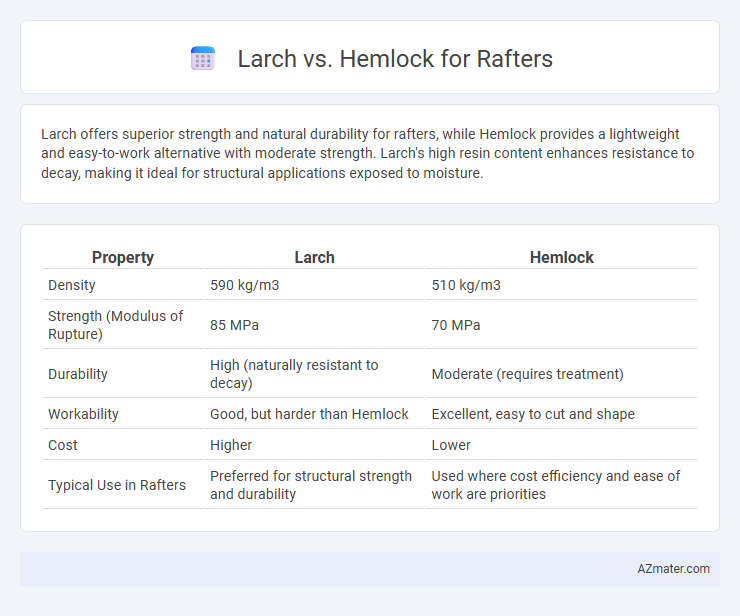Larch offers superior strength and natural durability for rafters, while Hemlock provides a lightweight and easy-to-work alternative with moderate strength. Larch's high resin content enhances resistance to decay, making it ideal for structural applications exposed to moisture.
Table of Comparison
| Property | Larch | Hemlock |
|---|---|---|
| Density | 590 kg/m3 | 510 kg/m3 |
| Strength (Modulus of Rupture) | 85 MPa | 70 MPa |
| Durability | High (naturally resistant to decay) | Moderate (requires treatment) |
| Workability | Good, but harder than Hemlock | Excellent, easy to cut and shape |
| Cost | Higher | Lower |
| Typical Use in Rafters | Preferred for structural strength and durability | Used where cost efficiency and ease of work are priorities |
Introduction to Larch and Hemlock Rafters
Larch rafters are prized for their exceptional strength, durability, and natural resistance to decay, making them ideal for structural applications in roofing. Hemlock rafters offer a lighter yet stable option, valued for their fine grain and workability, often chosen for interior framing and detailed carpentry. Both woods provide reliable support in roofing, with larch favored for heavy-duty exterior exposure and hemlock suited for moderate load-bearing tasks with a smooth finish.
Wood Characteristics: Larch vs Hemlock
Larch wood is renowned for its high density, natural resistance to decay, and strong durability, making it ideal for load-bearing rafters exposed to moisture. Hemlock, while lighter and easier to work with, offers moderate strength and lower natural resistance to rot, requiring protective treatments for outdoor use. The choice between Larch and Hemlock rafters depends on balancing durability needs with ease of installation and environmental exposure.
Strength and Durability Comparison
Larch wood offers superior strength with a density of approximately 590 kg/m3, making it highly resistant to bending and compression stresses in rafters. Hemlock, while lighter with a density around 480 kg/m3, provides moderate durability but is more susceptible to weathering and insect damage than larch. For long-lasting rafters requiring high structural integrity, larch outperforms hemlock in both mechanical strength and natural decay resistance.
Resistance to Decay and Insects
Larch wood offers superior resistance to decay and insects compared to hemlock, making it an ideal choice for rafters exposed to moisture and pests. Its high resin content and dense grain structure enhance durability in outdoor and structural applications. Hemlock, while easier to work with, requires additional treatment to achieve similar levels of protection against fungal decay and insect damage.
Workability and Ease of Construction
Larch offers superior workability for rafters due to its moderate density and straight grain, making it easier to saw, nail, and shape compared to Hemlock, which tends to be softer but can splinter under stress. Hemlock's lighter weight facilitates easier handling on-site, yet it may require more cautious fastening to prevent damage during construction. Choosing Larch often results in smoother installation with fewer adjustments, while Hemlock demands skilled carpentry to maintain structural integrity and finish quality.
Cost Differences: Larch vs Hemlock
Larch wood typically costs more than hemlock due to its higher density, durability, and resistance to decay, making it a premium choice for rafters in construction. Hemlock is generally more affordable and widely available, which makes it a cost-effective option for projects with budget constraints. The price disparity affects material selection, impacting overall project expenses and long-term maintenance costs.
Environmental Sustainability
Larch wood, known for its natural durability and resistance to decay, is often sourced from sustainably managed forests, making it an environmentally sound choice for rafters. Hemlock, while also renewable, tends to come from faster-growing plantations with lower ecological impact but may require chemical treatments to enhance its longevity. Choosing larch can reduce environmental footprints due to its longer lifespan and minimal processing, whereas hemlock offers a balance of rapid renewability and affordability, requiring careful consideration of treatment methods.
Aesthetic Qualities and Grain Patterns
Larch rafters exhibit a distinctive golden to reddish-brown hue with prominent, straight grain patterns that enhance rustic and natural architectural designs. Hemlock rafters feature a lighter, creamy color with a fine, even grain that creates a smooth, uniform appearance ideal for modern or minimalist aesthetics. Both woods provide unique visual textures, but larch emphasizes warmth and ruggedness while hemlock offers subtle elegance and consistency.
Regional Availability and Sourcing
Larch and Hemlock differ significantly in regional availability, with Larch predominantly sourced from Northern and Eastern Europe, particularly Russia and Scandinavia, where its dense grain suits rafter construction. Hemlock is mainly harvested in the Pacific Northwest of the United States and Western Canada, known for its uniform texture and ease of milling, making it widely accessible in North American markets. Sourcing Larch often involves considerations of higher resin content and durability in damp climates, while Hemlock is favored for its lighter weight and consistent straight grain, influencing regional preferences for rafter use.
Best Use Cases: Choosing the Right Wood for Rafters
Larch wood offers exceptional strength, durability, and natural resistance to rot, making it ideal for exterior rafters exposed to harsh weather conditions. Hemlock, while less durable, is lighter and easier to work with, making it suitable for interior rafters or applications where weight is a concern. Choosing between larch and hemlock depends on the structural demands and environmental exposure of the rafter installation.

Infographic: Larch vs Hemlock for Rafter
 azmater.com
azmater.com